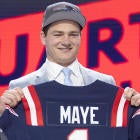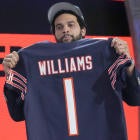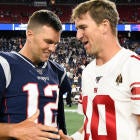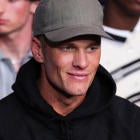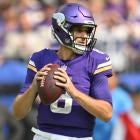
As has become clearer and clearer year after year, offense is king in the modern NFL. In recent seasons, nothing has been more determinative in team success in a given season than how your offense held up over the course of the year.
Who is your quarterback? Who is protecting him? Who does he throw to? Who does he have next to him in the backfield? Who's scheming those players open? Are there injury or depth issues at any or all of those positions? All the pieces matter. The degree to which they matter varies greatly, of course, but each plays a role in making an offense hum at peak efficiency.
Welcome to our third annual offensive infrastructure rankings. A few important notes before we begin:
- We used a weighted grading system where each team was given a 1-5 ranking (1 = terrible, 3 = average, 5 = elite) in the following areas: Quarterback, Play-Caller (head coach or offensive coordinator), Offensive Line, Pass-Catchers (WR/TE), and Running Backs.
- Those scores were then weighted so that the quarterback was the most important component of the offense, followed by play-caller, offensive line, and pass-catchers, and then finally running backs, so that the weights reflected as closely as possible the reality of the way modern NFL offenses work.
- In the event that teams ended up with the same weighted score, the first tiebreaker was the quarterback ranking. The second tiebreaker was the combined rankings of the play-caller and offensive line.
- These are not rankings of how we expect these offenses to perform during the 2022 season. They're an attempt to capture which offenses are best positioned for success based on the quality of their quarterback and the talent the organization has chosen to surround him. There is, of course, the possibility that players elevate their games (like Joe Burrow did in 2021) or transcend their supporting cast (as Russell Wilson did almost every year before last season), or that a quarterback's subpar performance undermines an otherwise strong offensive unit (like Baker Mayfield in 2021).
- Just as I did the past two years, I compiled an initial draft of these rankings, which I then ran by the rest of the writers, editors, and podcasters on the CBSSports.com NFL staff. I incorporated their feedback to create the version of the rankings you'll see below. The commentary in each section is mine.
Got all that? OK, great. Here we go...
Tier 6: 32-31
Team | QB | PC | OL | WR/TE | RB | Total | Weighted | Non-QB |
32. Chicago Bears | 2.5 | 3 | 2 | 1 | 4 | 12 | 2.30 | 2.20 |
31. Houston Texans | 2 | 4 | 2 | 2 | 2.5 | 12.5 | 2.43 | 2.65 |
So, yeah. The Bears offense is going to be rough. Chicago's new front-office regime was left with precious little resources to put a strong foundation around Justin Fields, and ended up using most of those resources on the defensive side of the ball anyway. The Bears did not have much in the way of free-agent capital, and did not have a first-round pick. They let one of their best offensive linemen leave in free agency, and saw Allen Robinson leave as well. Now, they're left with one of the NFL's worst offensive lines, its weakest pass-catching corps, and not much else. We at least know that Texans offensive coordinator Pep Hamilton has a track record of putting players in position to succeed, but Houston is still severely lacking in the talent department.
Tier 5: 31-28
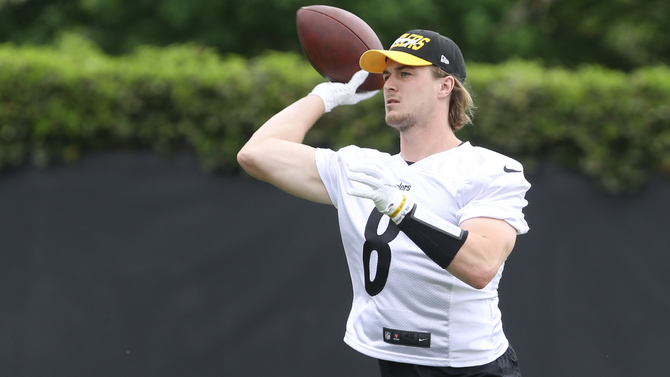
Team | QB | PC | OL | WR/TE | RB | Total | Weighted | Non-QB |
2 | 2 | 3 | 3 | 4.5 | 14.5 | 2.57 | 2.85 | |
29. Seattle Seahawks | 2 | 3 | 2.5 | 4 | 3 | 14.5 | 2.77 | 3.15 |
28. Atlanta Falcons | 2.5 | 4 | 3 | 2 | 2.5 | 14 | 2.80 | 2.95 |
2 | 3 | 3 | 4 | 4 | 16 | 2.93 | 3.40 |
We expect each of these teams to have below-average (or worse) quarterback play, and they're all saddled with some combination of below-average units along the offensive line or the pass-catching corps, or (in the case of the Panthers) a below-average play-caller. We also don't really know who will be under center for any of these squads. The Panthers could stick with Sam Darnold, turn to Matt Corral, or trade for someone like Baker Mayfield or Jimmy Garoppolo. The Seahawks could go with Drew Lock or Geno Smith, or make a trade. The Steelers seem likely to at least begin the season with Mitchell Trubisky at the helm, but could eventually turn to first-round pick Kenny Pickett. Marcus Mariota figures to get the first shot in Atlanta, but Desmond Ridder could work his way into the lineup. None of these teams necessarily has an elite unit at any spot, since we can no longer count on Christian McCaffrey to stay healthy and play damn near every snap.
Tier 4: 26-20
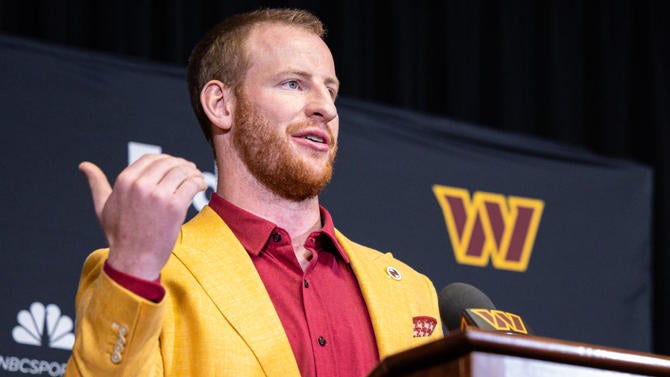
Team | QB | PC | OL | WR/TE | RB | Total | Weighted | Non-QB |
26. New York Jets | 2.5 | 3.5 | 3 | 3.5 | 3.5 | 16 | 3.07 | 3.35 |
25. Detroit Lions | 2.5 | 3 | 4 | 3 | 4 | 16.5 | 3.10 | 3.40 |
3 | 3 | 3.5 | 3 | 3.5 | 16 | 3.13 | 3.20 | |
2.5 | 3.5 | 3.5 | 3.5 | 3.5 | 16.5 | 3.17 | 3.50 | |
22. New York Giants | 2.5 | 4.5 | 3 | 3.5 | 3 | 16.5 | 3.23 | 3.60 |
3 | 4 | 3 | 3 | 3.5 | 16.5 | 3.23 | 3.35 | |
20. Tennessee Titans | 3.5 | 3.5 | 3.5 | 2.5 | 4.5 | 17.5 | 3.37 | 3.30 |
Let's call this group "not bad, but also maybe not that good." There are some intriguing units in here, like the Jets' offensive line and pass-catchers; the Lions' offensive line and running backs; the Giants' pass-catchers; and obviously, the Titans' running backs. But there are just too many question marks, especially at quarterback, to consider any of these teams likely to rank among the top half of the league in offensive efficiency, explosive play-making, scoring, or yardage.
Tier 3: 19-11
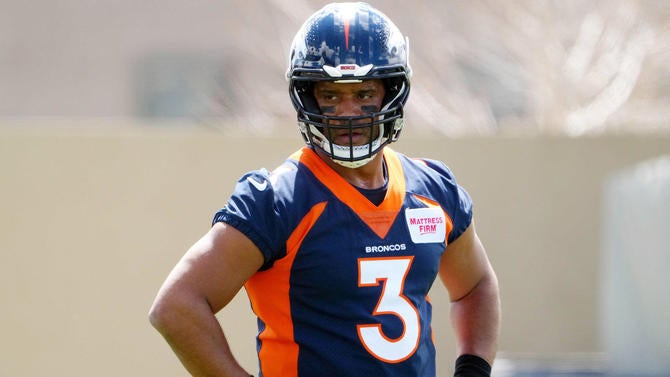
Team | QB | PC | OL | WR/TE | RB | Total | Weighted | Non-QB |
19. Miami Dolphins | 3 | 3.5 | 3.5 | 4.5 | 3 | 17.5 | 3.50 | 3.75 |
3.5 | 3 | 3.5 | 4.5 | 5 | 19.5 | 3.70 | 3.80 | |
3.5 | 4.5 | 3.5 | 3 | 5 | 19.5 | 3.70 | 3.80 | |
3 | 4 | 4.5 | 3.5 | 4.5 | 19.5 | 3.70 | 4.05 | |
4 | 3.5 | 3.5 | 4 | 3.5 | 18.5 | 3.77 | 3.65 | |
2.5 | 5 | 4 | 4.5 | 4 | 20 | 3.80 | 4.45 | |
13. Baltimore Ravens | 4.5 | 4 | 4 | 3 | 3.5 | 19 | 3.93 | 3.65 |
4 | 4.5 | 3 | 4.5 | 3.5 | 19.5 | 3.97 | 3.95 | |
11. Denver Broncos | 4.5 | 3 | 4 | 4 | 4 | 19.5 | 3.97 | 3.70 |
We can consider this tier the "above-average, but not quite great" group. With one exception, they all have quarterbacks who are somewhere between pretty good and very good. They all have above-average or better offensive lines, play-callers, and pass-catchers. None of them has a hole at running back. But these teams also don't necessarily have elite units, with the exception of the Colts (Jonathan Taylor), Vikings (Dalvin Cook and Alexander Mattison), and 49ers (Kyle Shanahan).
If Jaylen Waddle can maintain last year's volume but become more efficient, and Tyreek Hill remains the same explosive threat he was in Kansas City, the Dolphins can get there. If Adam Thielen staves off age-related aggression and a third pass-catcher emerges alongside him and Justin Jefferson, the Vikings can as well. If Derek Carr and Davante Adams recapture their college chemistry, the Raiders might, as well. If Lamar Jackson and/or Russell Wilson rediscover their peak form, so can the Ravens and Broncos.
Tier 2: 10-6

Team | QB | PC | OL | WR/TE | RB | Total | Weighted | Non-QB |
10. Cleveland Browns | 4 | 4 | 4.5 | 3.5 | 5 | 20 | 4.07 | 4.10 |
4 | 4 | 4.5 | 4 | 3.5 | 21 | 4.07 | 4.10 | |
4.5 | 3.5 | 3.5 | 5 | 4 | 20.5 | 4.17 | 4.00 | |
4.5 | 4 | 4 | 4 | 4 | 20.5 | 4.17 | 4.00 | |
5 | 3.5 | 3.5 | 4.5 | 3 | 19.5 | 4.17 | 3.75 |
This group of teams is right on the verge of breaking into the elite group, but with one thing or another holding us back from putting them in there. They should, however, all get somewhere between very good and elite quarterback play (assuming Deshaun Watson plays at some point this season, and the Browns do not have Jacoby Brissett under center all year); and with the exception of the Bills, they each have play-callers who have shown the ability to coordinate efficient and explosive offenses. We dinged Zac Taylor for his conservative tendencies, and gave Ken Dorsey a little bit of the benefit of the doubt by nudging his ranking a half-point above where we usually put rookie play-callers.
Cleveland's pass-catcher corps still leaves something to be desired, even with Amari Cooper in tow, and of course, there is the question of whether Watson will be on the field. Jalen Hurts's ranking here is a bit aggressive, given what he's shown as a passer, but his running ability lifts Philly's running backs to a higher level, so we gave him credit for that. The Bengals overhauled their offensive line, and it should be better, but we need to see it in action before giving it a better grade. Dallas has health question marks at every spot except for quarterback.
Tier 1: 5-1
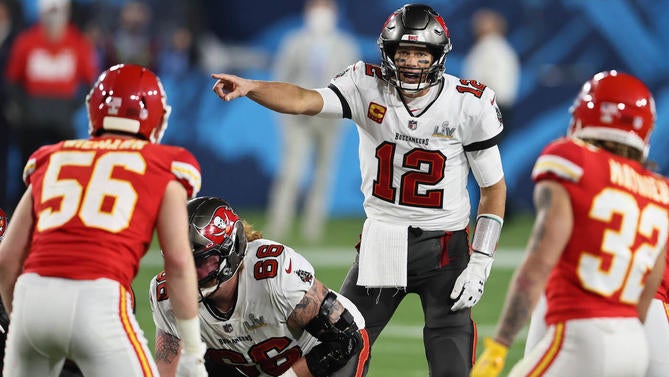
Team | QB | PC | OL | WR/TE | RB | Total | Weighted | Non-QB |
5 | 5 | 4 | 2.5 | 5 | 21.5 | 4.30 | 3.95 | |
5 | 4 | 4 | 4 | 4.5 | 21.5 | 4.37 | 4.05 | |
5 | 5 | 4 | 3.5 | 3 | 20.5 | 4.37 | 4.05 | |
4.5 | 5 | 4 | 4.5 | 3.5 | 21.5 | 4.43 | 4.40 | |
5 | 4 | 5 | 4.5 | 4 | 22.5 | 4.63 | 4.45 |
This is our best of the best group, and it should come as no surprise that they are all between above-average and elite pretty much across the board. There are no weaknesses under center, along the offensive line, or among the play-callers who are in charge of putting the offense in position to succeed.
The Packers and Chiefs have lower pass-catcher ratings than in previous seasons after trading away Davante Adams and Tyreek Hill, respectively, which is how several teams were able to pass them in the overall rankings. The Chargers have been steadily climbing each year we've done these rankings, and this time around they have crashed the top five. If Justin Herbert continues to ascend, they could eventually make it to the top spot.
The Rams swapping out Robert Woods (recovering from a torn ACL) for Allen Robinson and replacing Andrew Whitworth with Joseph Noteboom kept them among the elite units. The Bucs are tied for the highest non-QB rating among the league's 32 teams, but the difference between them and the 49ers is that they have Tom Brady at quarterback, while San Francisco has a question mark in Trey Lance. That's why the Bucs checked in first overall, while the Niners finished 14th.














